MITSUBISHI GRANDIS 2008 Owner's Manual (in English)
Manufacturer: MITSUBISHI, Model Year: 2008, Model line: GRANDIS, Model: MITSUBISHI GRANDIS 2008Pages: 458, PDF Size: 18.52 MB
Page 201 of 458
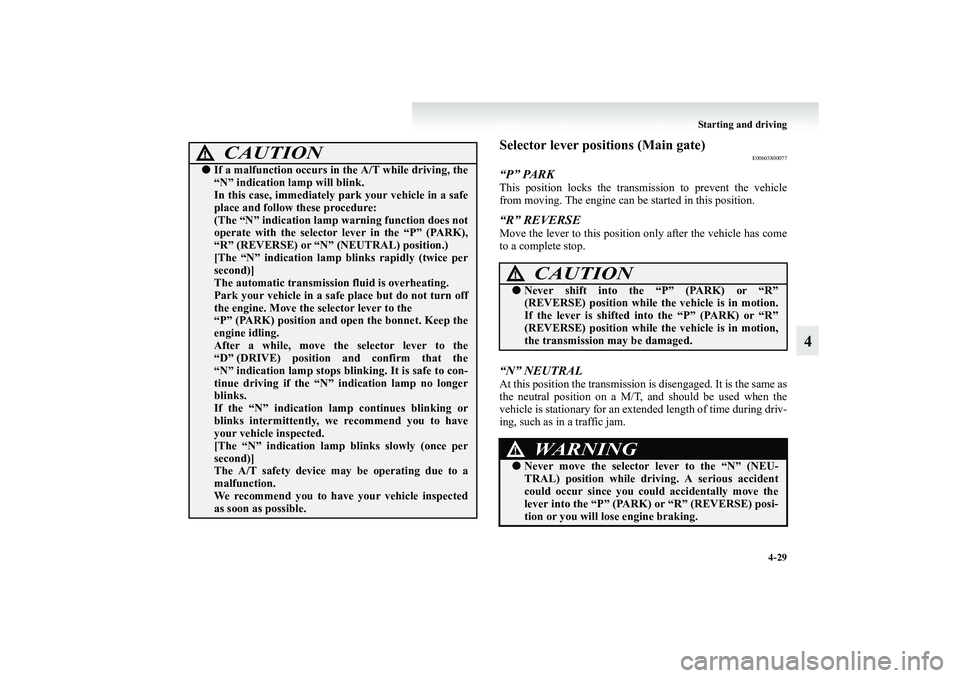
Starting and driving
4-29
4
Selector lever positions (Main gate)
E00603800077
“P” PARKThis position locks the transmission to prevent the vehicle
from moving. The engine can be started in this position.“R” REVERSEMove the lever to this position only after the vehicle has come
to a complete stop.“N” NEUTRALAt this position the transmission is disengaged. It is the same as
the neutral position on a M/T, and should be used when the
vehicle is stationary for an extended length of time during driv-
ing, such as in a traffic jam.
CAUTION
!●If a malfunction occurs in the A/T while driving, the
“N” indication lamp will blink.
In this case, immediately park your vehicle in a safe
place and follow these procedure:
(The “N” indication lamp warning function does not
operate with the selector lever in the “P” (PARK),
“R” (REVERSE) or “N” (NEUTRAL) position.)
[The “N” indication lamp blinks rapidly (twice per
second)]
The automatic transmission fluid is overheating.
Park your vehicle in a safe place but do not turn off
the engine. Move the selector lever to the
“P” (PARK) position and open the bonnet. Keep the
engine idling.
After a while, move the selector lever to the
“D” (DRIVE) position and confirm that the
“N” indication lamp stops blinking. It is safe to con-
tinue driving if the “N” indication lamp no longer
blinks.
If the “N” indication lamp continues blinking or
blinks intermittently, we recommend you to have
your vehicle inspected.
[The “N” indication lamp blinks slowly (once per
second)]
The A/T safety device may be operating due to a
malfunction.
We recommend you to have your vehicle inspected
as soon as possible.
CAUTION
!●Never shift into the “P” (PARK) or “R”
(REVERSE) position while the vehicle is in motion.
If the lever is shifted into the “P” (PARK) or “R”
(REVERSE) position while the vehicle is in motion,
the transmission may be damaged.
WARNING
!●Never move the selector lever to the “N” (NEU-
TRAL) position while driving. A serious accident
could occur since you could accidentally move the
lever into the “P” (PARK) or “R” (REVERSE) posi-
tion or you will lose engine braking.
BK-XP08E1ENUK.en-uk.book Page 29 Monday, August 13, 2007 2:20 PM
Page 202 of 458
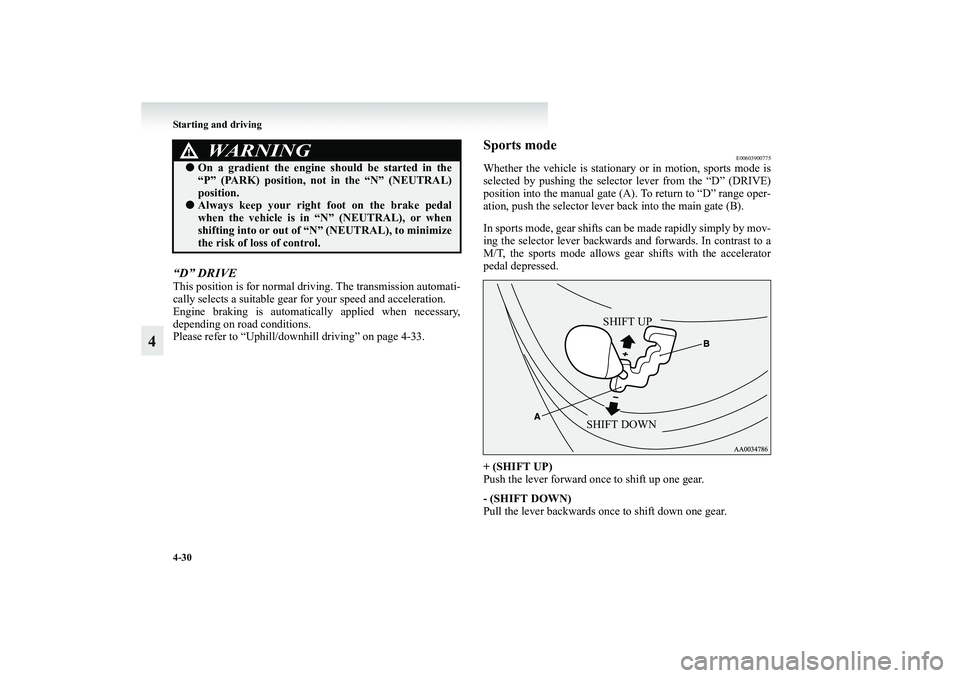
4-30 Starting and driving
4
“D” DRIVEThis position is for normal driving. The transmission automati-
cally selects a suitable gear for your speed and acceleration.
Engine braking is automatically applied when necessary,
depending on road conditions.
Please refer to “Uphill/downhill driving” on page 4-33.
Sports mode
E00603900775
Whether the vehicle is stationary or in motion, sports mode is
selected by pushing the selector lever from the “D” (DRIVE)
position into the manual gate (A). To return to “D” range oper-
ation, push the selector lever back into the main gate (B).
In sports mode, gear shifts can be made rapidly simply by mov-
ing the selector lever backwards and forwards. In contrast to a
M/T, the sports mode allows gear shifts with the accelerator
pedal depressed.
+ (SHIFT UP)
Push the lever forward once to shift up one gear.
- (SHIFT DOWN)
Pull the lever backwards once to shift down one gear.
●On a gradient the engine should be started in the
“P” (PARK) position, not in the “N” (NEUTRAL)
position.●Always keep your right foot on the brake pedal
when the vehicle is in “N” (NEUTRAL), or when
shifting into or out of “N” (NEUTRAL), to minimize
the risk of loss of control.
WARNING
!
SHIFT UP
SHIFT DOWN
BK-XP08E1ENUK.en-uk.book Page 30 Monday, August 13, 2007 2:20 PM
Page 203 of 458
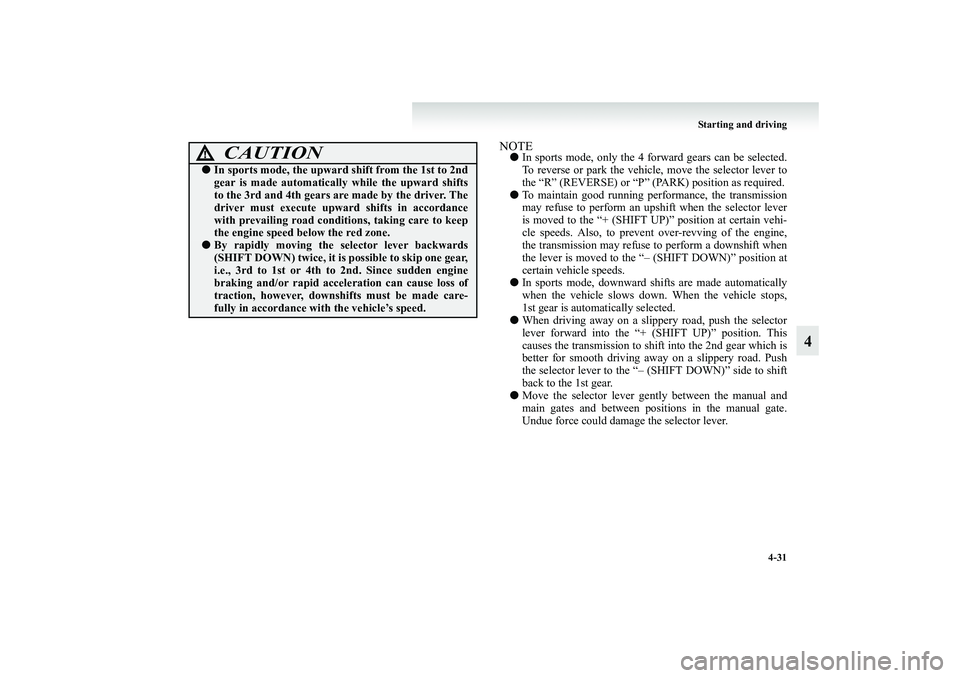
Starting and driving
4-31
4
NOTE●In sports mode, only the 4 forward gears can be selected.
To reverse or park the vehicle, move the selector lever to
the “R” (REVERSE) or “P” (PARK) position as required.
●To maintain good running performance, the transmission
may refuse to perform an upshift when the selector lever
is moved to the “+ (SHIFT UP)” position at certain vehi-
cle speeds. Also, to prevent over-revving of the engine,
the transmission may refuse to perform a downshift when
the lever is moved to the “– (SHIFT DOWN)” position at
certain vehicle speeds.
●In sports mode, downward shifts are made automatically
when the vehicle slows down. When the vehicle stops,
1st gear is automatically selected.
●When driving away on a slippery road, push the selector
lever forward into the “+ (SHIFT UP)” position. This
causes the transmission to shift into the 2nd gear which is
better for smooth driving away on a slippery road. Push
the selector lever to the “– (SHIFT DOWN)” side to shift
back to the 1st gear.
●Move the selector lever gently between the manual and
main gates and between positions in the manual gate.
Undue force could damage the selector lever.
CAUTION
!●In sports mode, the upward shift from the 1st to 2nd
gear is made automatically while the upward shifts
to the 3rd and 4th gears are made by the driver. The
driver must execute upward shifts in accordance
with prevailing road conditions, taking care to keep
the engine speed below the red zone.●By rapidly moving the selector lever backwards
(SHIFT DOWN) twice, it is possible to skip one gear,
i.e., 3rd to 1st or 4th to 2nd. Since sudden engine
braking and/or rapid acceleration can cause loss of
traction, however, downshifts must be made care-
fully in accordance with the vehicle’s speed.
BK-XP08E1ENUK.en-uk.book Page 31 Monday, August 13, 2007 2:20 PM
Page 204 of 458

4-32 Starting and driving
4
Sports mode indicator lamp
E00612300010
In sports mode, the currently selected position is indicated on
the instrument panel.NOTE●When sports mode is selected, the “D” indicator lamp
goes off.
Operation of the A/T
E00604200065
CAUTION
!●Before selecting a gear with the engine running and
the vehicle stationary, fully depress the brake pedal
to prevent the vehicle from creeping.
The vehicle will begin to move as soon as the gear is
engaged, especially when the engine speed is high, at
fast idle or with the air conditioning operating, the
brakes should only be released when you are ready
to drive away.●Depress the brake pedal with the right foot at all
times.
Using the left foot could cause driver movement
delay in case of an emergency.●To prevent sudden acceleration, never race the
engine when shifting from the “P” (PARK) or
“N” (NEUTRAL) position.●Operating the accelerator pedal while the other foot
is resting on the brake pedal will affect braking effi-
ciency and may cause premature wear of brake
pads.
Do not race the engine with brake pedal pressed.
This can damage the transmission.
Also, when the vehicle is stationary, the engine revo-
lutions may not rise to the same revolutions as meas-
ured in normal starting even if the accelerator pedal
is depressed while the brake pedal is being pressed.
BK-XP08E1ENUK.en-uk.book Page 32 Monday, August 13, 2007 2:20 PM
Page 205 of 458
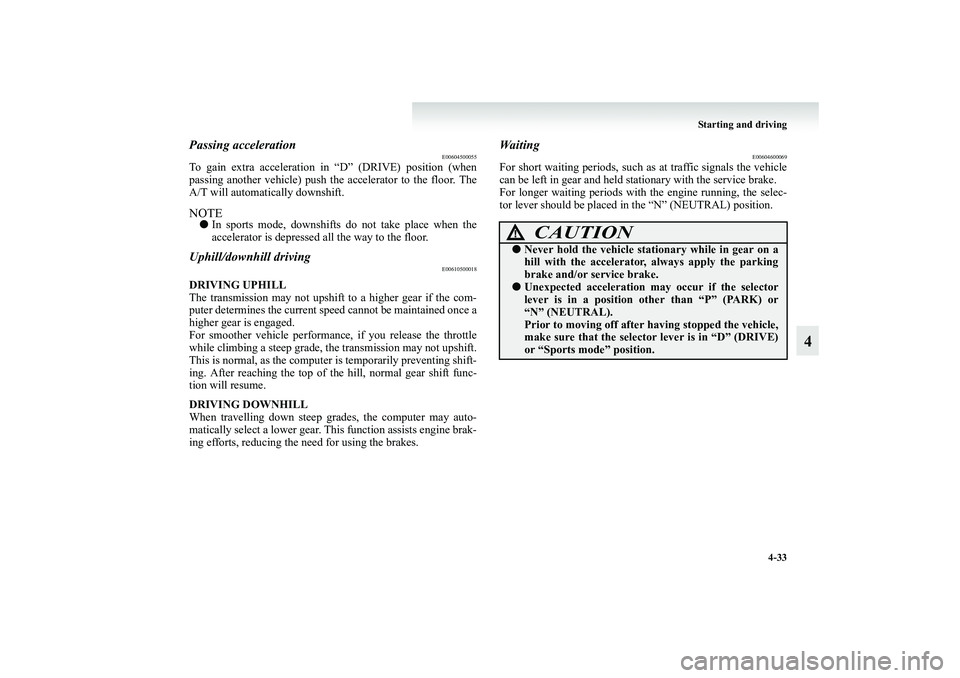
Starting and driving
4-33
4
Passing acceleration
E00604500055
To gain extra acceleration in “D” (DRIVE) position (when
passing another vehicle) push the accelerator to the floor. The
A/T will automatically downshift.NOTE●In sports mode, downshifts do not take place when the
accelerator is depressed all the way to the floor.Uphill/downhill driving
E00610500018
DRIVING UPHILL
The transmission may not upshift to a higher gear if the com-
puter determines the current speed cannot be maintained once a
higher gear is engaged.
For smoother vehicle performance, if you release the throttle
while climbing a steep grade, the transmission may not upshift.
This is normal, as the computer is temporarily preventing shift-
ing. After reaching the top of the hill, normal gear shift func-
tion will resume.
DRIVING DOWNHILL
When travelling down steep grades, the computer may auto-
matically select a lower gear. This function assists engine brak-
ing efforts, reducing the need for using the brakes.
Waiting
E00604600069
For short waiting periods, such as at traffic signals the vehicle
can be left in gear and held stationary with the service brake.
For longer waiting periods with the engine running, the selec-
tor lever should be placed in the “N” (NEUTRAL) position.
CAUTION
!●Never hold the vehicle stationary while in gear on a
hill with the accelerator, always apply the parking
brake and/or service brake.●Unexpected acceleration may occur if the selector
lever is in a position other than “P” (PARK) or
“N” (NEUTRAL).
Prior to moving off after having stopped the vehicle,
make sure that the selector lever is in “D” (DRIVE)
or “Sports mode” position.
BK-XP08E1ENUK.en-uk.book Page 33 Monday, August 13, 2007 2:20 PM
Page 206 of 458

4-34 Starting and driving
4
Parking
E00604700233
To park the vehicle, first bring it to a complete stop, fully
engage the parking brake, and then move the selector lever to
the “P” (PARK) position.
If you are going to leave the vehicle unattended, always switch
off the engine and remove the ignition key.NOTE●On a slope, be sure to apply the parking brake before
moving the selector lever to the “P” (PARK) position. If
you move the selector lever to the “P” (PARK) position
before applying the parking brake, it may be difficult to
disengage the selector lever from the “P” (PARK) position
when next you drive the vehicle, requiring application of a
strong force to the selector lever to move from the “P”
(PARK) position.
When the A/T makes no speed change
E00604800351
If the transmission does not change speeds while driving, or
your vehicle does not pick up enough speed when starting on
an uphill slope, it may be that there is something unusual hap-
pening in the transmission, causing a safety device to activate.
We recommend you to have your vehicle checked as soon as
possible.
1. If your vehicle has difficulty moving uphill, shift the
selector lever into 2nd gear of the sports mode.
This method might not work depending on the type of
transmission malfunction.
2. Once the vehicle is moving on a level road, move the
selector lever back to “D” (DRIVE).NOTE●When the “N” indication lamp in the instrument panel
blinks, it means that there is an abnormal condition in the
transmission. Refer to “Selector lever position indication
lamps/“N” indication lamp” on page 4-28.
BK-XP08E1ENUK.en-uk.book Page 34 Monday, August 13, 2007 2:20 PM
Page 207 of 458
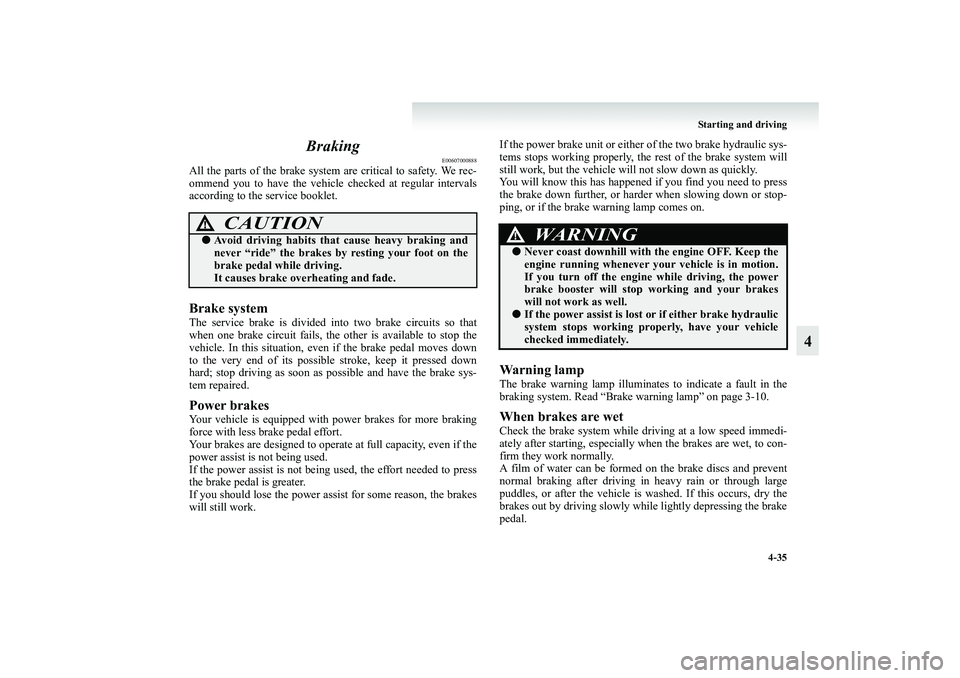
Starting and driving
4-35
4 Braking
E00607000888
All the parts of the brake system are critical to safety. We rec-
ommend you to have the vehicle checked at regular intervals
according to the service booklet.Brake systemThe service brake is divided into two brake circuits so that
when one brake circuit fails, the other is available to stop the
vehicle. In this situation, even if the brake pedal moves down
to the very end of its possible stroke, keep it pressed down
hard; stop driving as soon as possible and have the brake sys-
tem repaired.Power brakesYour vehicle is equipped with power brakes for more braking
force with less brake pedal effort.
Your brakes are designed to operate at full capacity, even if the
power assist is not being used.
If the power assist is not being used, the effort needed to press
the brake pedal is greater.
If you should lose the power assist for some reason, the brakes
will still work.If the power brake unit or either of the two brake hydraulic sys-
tems stops working properly, the rest of the brake system will
still work, but the vehicle will not slow down as quickly.
You will know this has happened if you find you need to press
the brake down further, or harder when slowing down or stop-
ping, or if the brake warning lamp comes on.
Wa r n i n g l a m pThe brake warning lamp illuminates to indicate a fault in the
braking system. Read “Brake warning lamp” on page 3-10.When brakes are wetCheck the brake system while driving at a low speed immedi-
ately after starting, especially when the brakes are wet, to con-
firm they work normally.
A film of water can be formed on the brake discs and prevent
normal braking after driving in heavy rain or through large
puddles, or after the vehicle is washed. If this occurs, dry the
brakes out by driving slowly while lightly depressing the brake
pedal.
CAUTION
!●Avoid driving habits that cause heavy braking and
never “ride” the brakes by resting your foot on the
brake pedal while driving.
It causes brake overheating and fade.
WARNING
!●Never coast downhill with the engine OFF. Keep the
engine running whenever your vehicle is in motion.
If you turn off the engine while driving, the power
brake booster will stop working and your brakes
will not work as well.●If the power assist is lost or if either brake hydraulic
system stops working properly, have your vehicle
checked immediately.
BK-XP08E1ENUK.en-uk.book Page 35 Monday, August 13, 2007 2:20 PM
Page 208 of 458
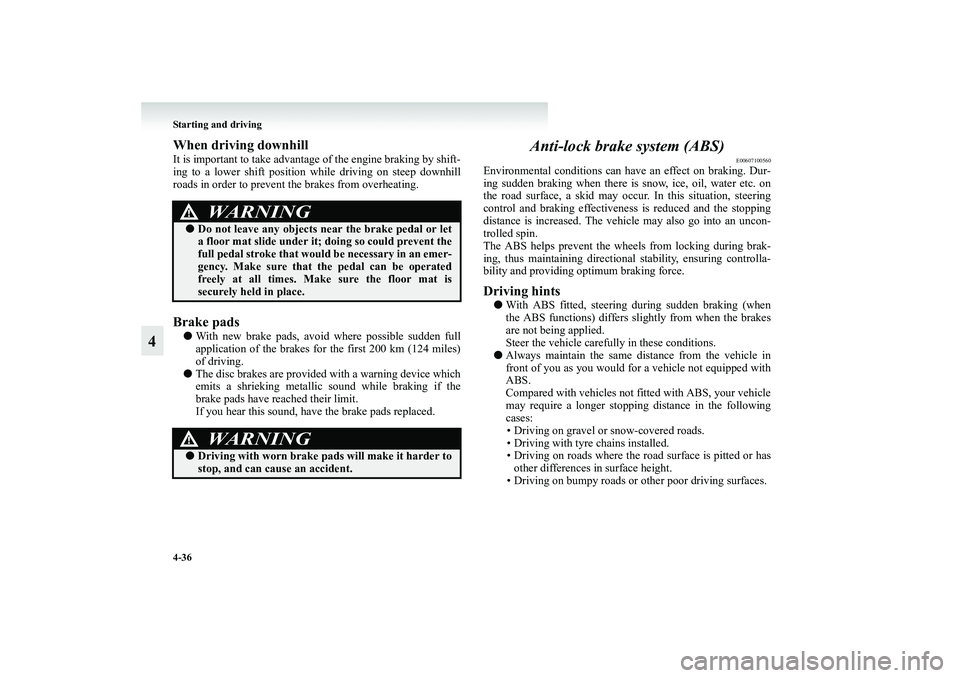
4-36 Starting and driving
4
When driving downhillIt is important to take advantage of the engine braking by shift-
ing to a lower shift position while driving on steep downhill
roads in order to prevent the brakes from overheating.Brake pads●With new brake pads, avoid where possible sudden full
application of the brakes for the first 200 km (124 miles)
of driving.
●The disc brakes are provided with a warning device which
emits a shrieking metallic sound while braking if the
brake pads have reached their limit.
If you hear this sound, have the brake pads replaced.
Anti-lock brake system (ABS)
E00607100560
Environmental conditions can have an effect on braking. Dur-
ing sudden braking when there is snow, ice, oil, water etc. on
the road surface, a skid may occur. In this situation, steering
control and braking effectiveness is reduced and the stopping
distance is increased. The vehicle may also go into an uncon-
trolled spin.
The ABS helps prevent the wheels from locking during brak-
ing, thus maintaining directional stability, ensuring controlla-
bility and providing optimum braking force.Driving hints●With ABS fitted, steering during sudden braking (when
the ABS functions) differs slightly from when the brakes
are not being applied.
Steer the vehicle carefully in these conditions.
●Always maintain the same distance from the vehicle in
front of you as you would for a vehicle not equipped with
ABS.
Compared with vehicles not fitted with ABS, your vehicle
may require a longer stopping distance in the following
cases:
• Driving on gravel or snow-covered roads.
• Driving with tyre chains installed.
• Driving on roads where the road surface is pitted or has
other differences in surface height.
• Driving on bumpy roads or other poor driving surfaces.
WARNING
!●Do not leave any objects near the brake pedal or let
a floor mat slide under it; doing so could prevent the
full pedal stroke that would be necessary in an emer-
gency. Make sure that the pedal can be operated
freely at all times. Make sure the floor mat is
securely held in place.
WARNING
!●Driving with worn brake pads will make it harder to
stop, and can cause an accident.
BK-XP08E1ENUK.en-uk.book Page 36 Monday, August 13, 2007 2:20 PM
Page 209 of 458

Starting and driving
4-37
4
●Operation of ABS is not restricted to situations where
brakes are applied suddenly. This system may also operate
to prevent wheel lock when you are driving over man-
holes, steel road-work plates, or the vehicle is driven over
steps or level differences in the road, road markings, or
other surfaces which are difficult for the wheels to grip.
●When the ABS is activated, you may feel the brake pedal
pulsating and hear a characteristic noise. Also at this time,
it may feel as if the pedal attempts to resist being
depressed.
In this situation, to let the ABS work for you, just hold
the brake pedal down more firmly. Do not pump the
brake. This will result in reduced braking perform-
ance.
CAUTION
!●Even the ABS cannot prevent the natural laws of
physics from acting on the vehicle. It cannot for
instance avoid accidents that may result from exces-
sive speed on bends or following another vehicle too
closely or aquaplaning. It should remain the driver’s
task to observe safety precautions to judge speeds
and brake applications correctly in such conditions.●Be sure to use tyres of the same type and size on
4 wheels.
If tyre types or sizes are mixed, ABS may not func-
tion normally.●Never install a limited slip differential, which is not
a MITSUBISHI MOTORS genuine part, as the ABS
may not function normally.
We recommend to consult a MITSUBISHI
MOTORS Authorized Service Point.
BK-XP08E1ENUK.en-uk.book Page 37 Monday, August 13, 2007 2:20 PM
Page 210 of 458
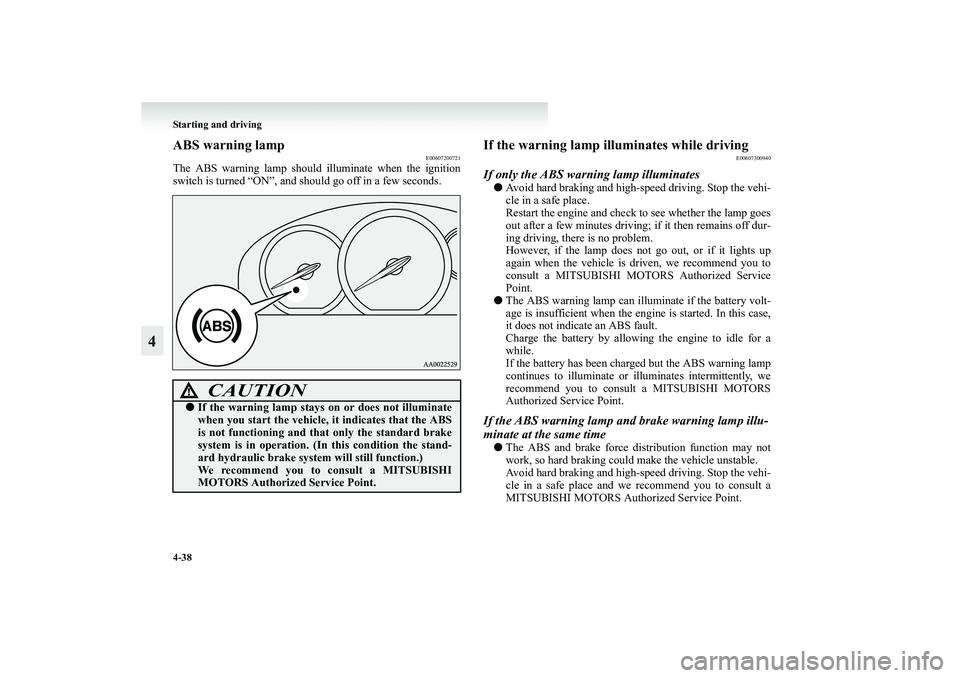
4-38 Starting and driving
4
ABS warning lamp
E00607200721
The ABS warning lamp should illuminate when the ignition
switch is turned “ON”, and should go off in a few seconds.
If the warning lamp illuminates while driving
E00607300940
If only the ABS warning lamp illuminates●Avoid hard braking and high-speed driving. Stop the vehi-
cle in a safe place.
Restart the engine and check to see whether the lamp goes
out after a few minutes driving; if it then remains off dur-
ing driving, there is no problem.
However, if the lamp does not go out, or if it lights up
again when the vehicle is driven, we recommend you to
consult a MITSUBISHI MOTORS Authorized Service
Point.
●The ABS warning lamp can illuminate if the battery volt-
age is insufficient when the engine is started. In this case,
it does not indicate an ABS fault.
Charge the battery by allowing the engine to idle for a
while.
If the battery has been charged but the ABS warning lamp
continues to illuminate or illuminates intermittently, we
recommend you to consult a MITSUBISHI MOTORS
Authorized Service Point.If the ABS warning lamp and brake warning lamp illu-
minate at the same time●The ABS and brake force distribution function may not
work, so hard braking could make the vehicle unstable.
Avoid hard braking and high-speed driving. Stop the vehi-
cle in a safe place and we recommend you to consult a
MITSUBISHI MOTORS Authorized Service Point.
CAUTION
!●If the warning lamp stays on or does not illuminate
when you start the vehicle, it indicates that the ABS
is not functioning and that only the standard brake
system is in operation. (In this condition the stand-
ard hydraulic brake system will still function.)
We recommend you to consult a MITSUBISHI
MOTORS Authorized Service Point.
BK-XP08E1ENUK.en-uk.book Page 38 Monday, August 13, 2007 2:20 PM